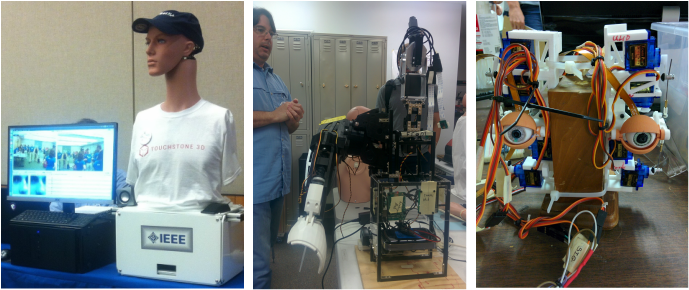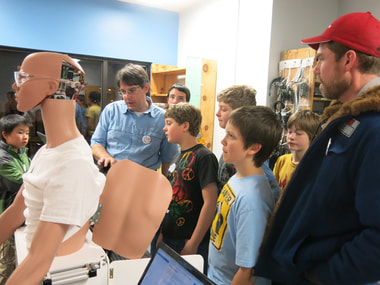Research Projects
Artificial Social Intelligence for Successful Teams (ASIST)
This four-year project aims to develop artificial intelligent agents to predict humans mental models in a search and rescue task environment. I am part of TA3 Evaluation team, designing experiments to test hypotheses regarding the humans and AI agents. Twelve universities and organizations are involved in developing the artificial social intelligent agents and testing the theories. September 2019 - present
Funded by DARPA
ASIST related websites:
https://www.darpa.mil/program/artificial-social-intelligence-for-successful-teams
https://artificialsocialintelligence.org/
https://www.aptima.com/testing-ai-social-intelligence/
https://news.asu.edu/20200901-solutions-testing-human-teammates-minecraft
https://www.cs.ucf.edu/~garibay/page_grant_asist.html
https://ischool.arizona.edu/news/new-asisttomcat-grant
https://www.dollabs.com/
https://www.csail.mit.edu/research/artificial-social-intelligence-successful-teams-asist
https://hrc2.io/projects/ASIST
https://osf.io/registries/darpaasist/discover
ASIST publications: (more to add)
ASIST Data:
ASIST pre-registrations and publications:
https://osf.io/registries/darpaasist/discover
https://www.zotero.org/groups/4703883/darpa_asist/items/LGJA4465/item-list
Funded by DARPA
ASIST related websites:
https://www.darpa.mil/program/artificial-social-intelligence-for-successful-teams
https://artificialsocialintelligence.org/
https://www.aptima.com/testing-ai-social-intelligence/
https://news.asu.edu/20200901-solutions-testing-human-teammates-minecraft
https://www.cs.ucf.edu/~garibay/page_grant_asist.html
https://ischool.arizona.edu/news/new-asisttomcat-grant
https://www.dollabs.com/
https://www.csail.mit.edu/research/artificial-social-intelligence-successful-teams-asist
https://hrc2.io/projects/ASIST
https://osf.io/registries/darpaasist/discover
ASIST publications: (more to add)
- Huang, L., Freeman, J. Cooke, N., Cohen, M., Yin, X., Clark, J., Wood, M., Buchanan, V., Corral, C., Scholcover, F., Mudigonda, A., Thomas, L., Teo, A., Colonna-Romano, J. (2023, in press) Establishing Human Observer Criterion in Evaluating Artificial Social Intelligence Agents in a Search and Rescue Task. Cognitive Science: Building the Socio-Cognitive Architecture of COHUMAIN: Collective Human-Machine Intelligence.
- Huang, L., Freeman, J., Cooke, N., Colonna-Romano, J., Wood, M. D., Buchanan, V., … Davoodi, T. (2022, June 2). Exercises for Artificial Social Intelligence in Minecraft Search and Rescue for Teams. Retrieved from osf.io/83vj2
- Freeman, J., Huang, L., Wood, M., Cauffman, S. (2021). Evaluating Artificial Social Intelligence in an Urban Search and Rescue Task Environment. Proceedings of the AAAI 2021 Fall Symposium, 4-6 Nov 2021. handle: 2286/R.2.N.162284
- Corral CC, Tatapudi KS, Buchanan V, Huang L, Cooke NJ. Building a Synthetic Task Environment to Support Artificial Social Intelligence Research. Proceedings of the Human Factors and Ergonomics Society Annual Meeting. 2021;65(1):660-664. doi:10.1177/1071181321651354a
- Huang, L., Freeman, J., Cooke, N., Dubrow, S., Colonna-Romano, J., Wood, M. D., … Caufman, S. J. (2021, June 10). ASIST Study 2 June 2021 Exercises for Artificial Social Intelligence in Minecraft Search and Rescue for Teams. Retrieved from osf.io/7nqe2
- Huang, L., Freeman, J., Cooke, N., Buchanan, V., Wood, M. D., Freiman, M., … Demir, M. (2021, January 4). Experiment 1 Preregistration. Retrieved from osf.io/29ma8
ASIST Data:
- Lixiao Huang; Jared Freeman; Nancy Cooke; Samantha Dubrow; John “JCR” Colonna-Romano; Matt Wood; Verica Buchanan; Stephen Caufman; Xiaoyun Yin, 2022, "Artificial Social Intelligence for Successful Teams (ASIST) Study 2", https://doi.org/10.48349/ASU/BZUZDE, ASU Library Research Data Repository, V4, UNF:6:OJ3XctVE31iBZs09zhPpFQ== [fileUNF]
ASIST pre-registrations and publications:
https://osf.io/registries/darpaasist/discover
https://www.zotero.org/groups/4703883/darpa_asist/items/LGJA4465/item-list
CHARTopolis
This project studies human's emotions, behaviors, and cognition on a shared road with self-driven cars and man-driven cars. February 2019 - present
Funded by ASU Global Security Initiative and Army Research Laboratory
Funded by ASU Global Security Initiative and Army Research Laboratory
Human-Autonomy Teaming Metrics and Models
This project explores human-human and human-agent teaming interactions and proposes interaction-based system-level measures of team performance and effectiveness. The context for the fundamental research focuses on the Next Generation Combat Vehicles (NGCV).
Funded by ARL
Funded by ARL
Human-Autonomy Interface for Exploration of Risks (HAIER)
The big title of the project is Trust in Risk-Aware, Human-Cooperative Autonomy. This goal is to examine the factors that influence humans' trust in autonomy in risky situations. Our team has been developing a software platform called Human-Autonomy Interface for Exploration of Risks (HAIER). More information can be found in the following link: http://apps.hal.pratt.duke.edu:8000/
Funded by ONR.
Funded by ONR.
Intrinsic motivation in Human-Robot Interaction
This project aims to investigate humans' motivations in interacting with robots, and what factors influence their motivation, and how to design the human robot interface accordingly to influence humans' motivations in HRI.
Self funded.
Self funded.
Humans' Emotional Attachment to Robots
This line of research is to find out the emotions people have developed toward robots and the influencing factors for the emotions, as well as developing a reliable instrument to measure the emotions. When it comes to emotional attachment, the concept is redefined with a new framework. So far we have explored human emotions with classroom robots, tournament robots, and favorite technological objects. Participants include college students, middle school students, high school students, and general public.
Self funded.
Self funded.
Group Interactions with Robots in Robotics Tournaments
Starting 2016, I have been using naturalistic observation method to study how team players interact with robots in robotics tournaments. The first goal is to find the behavioral pattens of human-robot interactions in a dynamic, real-life, and high time pressure environments. The next goal is to explore areas where human factors method might be used to help team players to perform their tasks better in robotics tournaments.
Self funded.
Self funded.
Human Reactions to a Humanoid Robot in Public STEM Education
The IEEE ENCS Humanoid Robot Project is a community outreach oriented project to educate the public especially children about science and engineering through the humanoid robot KEN. KEN has been invited to many organizations including museums and schools, and more than 500 people have been reached.
STEM Outreach Using Students-Built Humanoid Robots
|
In January 2016, the IEEE ENCS Humanoid Robot project was awarded the IEEE foundation grant, titled “STEM Outreach Using Students-Built Humanoid Robots”. The grant helps fund a yearlong mentoring and outreach program designed to teach students to build four versions of humanoid robots and for students to perform STEM outreach. The Humanoid Robot Project team has worked with The Forge Initiative, a local STEM nonprofit for the mission. In the past, the demonstrations and exhibitions of KEN provided one-time exposure to the general public to increase their awareness and interest in robotics and STEM. Collaborating with the Forge Initiative allows interested members to work closely with IEEE mentors and professionals to learn more about robotics through committed hands-on activities for longer periods of time. Here are two research questions about robotics education related to this project.
|
Uncanny Valley Effect and Mere Exposure
This research is to explore the mechanism of the uncanny valley effect for humanoid robots and solutions to overcome it.
Self funded.
Self funded.
Robotics Education
This line of research is to examine the current status of robotics education in classrooms and robotics clubs that prepare for robotics tournaments. I have looked into self-efficacy, problem solving skills, reflection journals, and metacognition. I am also interested in team formation and team learning dynamics.
Self funded.
Self funded.
Studio STEM: Afterschool Design-based Science Learning
This line of research is to assist Dr. Michael Evans with his Studio STEM project, which is to study middle school students’ engagement, learning process, and learning outcomes in a design-based science learning environment using multimodal data streams.
Funded by NSF.
Funded by NSF.


